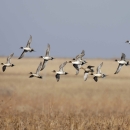About Us
Big Lake National Wildlife Refuge (NWR) contains 5,000 acres that is recognized as a National Natural Landmark National Natural Landmark
The National Natural Landmarks Program preserves sites illustrating the geological and ecological character of the United States. The program aims to enhance the scientific and educational value of the preserved sites, strengthen public appreciation of natural history and foster a greater concern for the conservation of the nation’s natural heritage. The program was established in 1962 by administrative action under the authority of the Historic Sites Act of 1935. The first National Natural Landmarks were designated in 1963. Today, there are more than 600 National Natural Landmarks in 48 states, American Samoa, Guam, Puerto Rico and the U.S. Virgin Islands.
Learn more about National Natural Landmark , and 2,144 acres that are part of the National Wilderness Preservation System. The refuge annually winters several species of waterfowl. Peak numbers in January and February can exceed 200,000 birds. Wood ducks are year-round residents and annually raise approximately 2,500 young on the refuge. Over 225 bird species have been observed on the refuge. Other wildlife to look for are beavers, river otters, raccoons, wild turkeys, white-tailed deer, bobcats, and the occasional armadillo.
The Wilderness Act of 1964 created the National Wilderness Preservation System in order "to assure that an increasing population, accompanied by expanding settlement and growing mechanization, does not occupy and modify all areas in the United States, and its possession, leaving no lands designated for preservation and protection in their natural condition..."
Big Lake Wilderness was established in 1976 and is 2,144 acres in size.
For more information on Big Lake Wilderness, please visit: Wilderness.net
Read about the refuge's history, wildlife, and more here: Big Lake NWR - General Brochure
Our Mission
Refuge management activities target water management, waterfowl, wetlands, forestry, wilderness stewardship, and compatible wildlife-dependent recreation.
Big Lake NWR’s official purposes are:
- “…as a refuge, reserve, and breeding ground for native birds” (Executive Order 2230, dated August 2, 1915).
- “…for use as an inviolate sanctuary, or for any other management purposes, for migratory birds. ” 16 U.S.C. 715d (Migratory Bird Conservation Act).
- ...and to manage the Big Lake Wilderness as part of the National Wilderness Preservation System according to the Wilderness Act of 1964, as compatible with the purposes for which Big Lake NWR was established.
Other Facilities in this Complex
A National Wildlife Refuge Complex is an administrative grouping of two or more refuges, wildlife management areas, or other refuge conservation areas that are primarily managed from a central office location. Refuges are grouped into a complex structure structure
Something temporarily or permanently constructed, built, or placed; and constructed of natural or manufactured parts including, but not limited to, a building, shed, cabin, porch, bridge, walkway, stair steps, sign, landing, platform, dock, rack, fence, telecommunication device, antennae, fish cleaning table, satellite dish/mount, or well head.
Learn more about structure because they occur in a similar ecological region, such as a watershed or specific habitat type, and have a related purpose and management needs. Typically, a project leader or complex manager oversees the general management of all refuges within the complex and refuge managers are responsible for operations at specific refuges. Supporting staff, composed of administrative, law enforcement, refuge manager, biological, fire, visitor services, and maintenance professionals, are centrally located and support all refuges within the complex.

